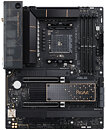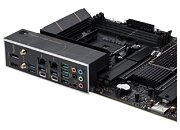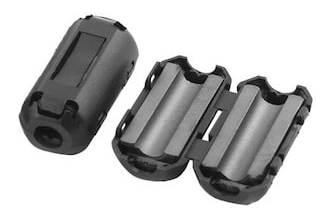Friday, August 13th 2021

ASUS Launches STRIX-E, ProArt Creator and TUF Pro AMD X570 Motherboards
ASUS today introduced a trio of new motherboards based on AMD's X570 chipset, which join the latest ROG Crosshair VIII Extreme as the latest offerings from ASUS on the X570 platform.
The ROG Strix X570-E Gaming WiFi II pairs the latest tech with essential ROG DNA
Elite gamers and enthusiasts who prefer the finer things in life will want to take a look at the new ROG Strix X570-E Gaming WiFi II. Building on the legacy of the ROG Strix X570-E Gaming WiFi before it, this fresh new board distills high-end components, smart software, and passive chipset cooling into one luxurious board. This revision of the X570-E makes a splash with revised ROG graphics running across the I/O shroud and the chipset heatsink. The CPU VRM also gets a boost to a 12+4-phase design, fueled by ProCool II auxiliary connectors. No matter your choice of Ryzen CPU, the new Strix-E will handle it with aplomb.Taking a page from the Crosshair VIII Extreme, this board features our exclusive Dynamic OC Switcher technology for getting the most out of your Ryzen CPU regardless of the workload. The onboard Q-Code display, diagnostic LEDs, and compatibility with DDR4 RAM up to 5100 MHz thanks to our OptiMem II trace layout will help your quest for peak performance. Keeping your machine cool is equally effortless thanks to five fan headers plus dedicated AIO and pump headers. PCIe 4.0-powered M.2 slots at mid-board and below the chipset heatsink can both accept storage devices up to 110 mm long, and both are bolstered by thick aluminium heatsinks for maximum sustained performance. These slots also include our tool-free Q-Latch feature for easy SSD installation.
Other areas of the Strix X570-E get notable improvements in this second generation. The wireless network controller is now a WiFi 6E radio with Bluetooth 5.2 support for easy connectivity with the latest routers and peripherals. A cable is still the top choice of many enthusiasts for the absolute lowest latency and most stable transfer speeds, and 2.5 Gigabit Ethernet and 1GbE ports deliver both in spades.
The rear panel counts seven USB 3.2 Gen 2 Type-A ports and a Type-C connector with the same spec. Onboard headers can provide another USB 3.2 Gen 2 port in either A or C flavors, plus two USB 3.2 Gen 1 and four USB 2.0 connectors. Those RGB strips you've ordered can hook up with the two Gen 2 addressable headers and the pair of standard RGB connectors.
In keeping with its luxe specs, the Strix-E features an ROG SupremeFX S1220A codec chip with an integrated headphone amplifier has a 120dB signal-to-noise ratio for spotless playback. Online gaming and conference calls are super-clear thanks to the high-quality microphone input, and Two-way AI Noise Cancelling tech cleans up background noise for both you and your teammates' voice comms. Last but by no means least, there's DTS Sound Unbound support for 3D audio, and an optical S/PDIF output for connectivity with gear that can accept digital inputs.
The ProArt X570-Creator WiFi maximizes creative potential
The ProArt X570-Creator WiFi is our first ProArt board to take advantage of the X570 chipset. If you're not familiar, the goal of the ProArt series is to deliver maximum performance and stability for all sorts of users who depend on their PC or workstation to make a living: 3D artists, CAD and CAM designers, audio and video producers, and even software developers.The ProArt X570-Creator WiFi is built to impress those demanding users. Dual Thunderbolt 4 USB-C ports with 40 Gbps of bandwidth each and 15 W Power Delivery charging support grace the rear panel. Each of those ports is ready for the latest audio-visual gear or speedy external disk arrays. The back panel offers DisplayPort input for easy single-cable connectivity with Thunderbolt displays. Other high-speed peripherals can hook right up to four USB 3.2 Gen 2 and four USB 3.2 Gen 1 ports. We extend high-speed connectivity to the front panel of modern cases with a USB 3.2 Gen 2 Type-C internal header.
AV professionals in particular routinely need to shuffle multi-terabyte files around, a task that the ProArt X570-Creator WiFi makes simple thanks to a 10 Gigabit Ethernet connector with a maximum transfer speed in excess of 1.2 GB per second. A secondary 2.5GbE connector expands the board's peak Ethernet bandwidth or preserves the 10G port's full speed for the most important transfers. For professionals who prefer to cut the cord, a WiFi 6E wireless adapter with Bluetooth 5.2 support makes for more flexible workstation placement and easy pairing with wireless peripherals.
Connectivity and bandwidth are a prime topic for the creator crowd, but there's also the matter of stability. A system that gives up the ghost under heavy load is no good when we're talking renders or compile jobs that take many hours to complete. The ProArt X570-Creator is ready for the most powerful Ryzen CPUs thanks to a VRM with a 14+2 stage design, fed by ProCool II solid-pin power connectors. Massive aluminium heatsinks cover the VRM power stages, X570 chipset, and three M.2 slots. Our tool-free Q-Latch mechanisms make slotting in NVMe drives a breeze.The objects in a creator's space can serve as inspiration of their own, and the ProArt X570-Creator is dressed for the part with coppery accents set against dark gray and black hardware. For those that want to express themselves in RGB, the ProArt X570-Creator has three Gen2 addressable RGB headers, plus a standard RGB strip connector.
Whether it's for an artist seeking background inspiration or an audio pro checking a mastered track, clean sound is crucial for any creative workstation. The ProArt X570-Creator WiFi features a premium S1220A codec with an integrated auto-sensing headphone amplifier, all wired through discrete audio paths with Japanese capacitors. Two-way AI Noise Cancelling cuts down on background noise and chatter in team meetings or client calls.
A build around this board will potentially live in a large department or corporate network, so we include the ASUS Control Center Express remote IT asset monitoring and management software—a blessing for your friendly systems administrator. At a local level, the ProArt Creator Hub application centralizes system monitoring and workload-specific optimization, as well as color calibration controls for compatible monitors. The app also offers our convenient Task Group feature so that you can quickly get down to work with one click. For just two examples, creators might pair DAW and streaming software, or a 3D modelling app with a texture design tool. Rather than digging through their desktop or Start menu to find these apps, they can launch them all at once with Task Group.
The TUF Gaming X570-Pro WiFi II is rock-steady and battle-ready
Our TUF Gaming hardware lineup follows three core tenets: a comprehensive selection of essential features, battle-tested reliability, and distinctive yet subtle styling. If you're looking for a high-performance and long-lasting motherboard at a reasonable price, look no further.
Any Ryzen CPU that you can drop into the AM4 socket will enjoy the stable power delivered by the 12+2 DrMOS VRM and 8+4-pin ProCool auxiliary power connectors. Meaty aluminium VRM heatsinks and a new passive chipset heatsink ensure that both the CPU and the X570 chipset can run all-out without fear of performance-robbing throttling. The main metal-encased PCIe slot and both M.2 slots are all connected with PCIe 4.0 for maximum available bandwidth.Upgraded networking capabilities are a theme of our new X570 boards, and the TUF Gaming X570-Pro WiFi II is no exception. 2.5 Gigabit Ethernet comes standard, and a Wi-Fi 6E module handles both next-gen WiFi and Bluetooth 5.2. You can enhance your build's aesthetics with the three RGB headers: one Gen 2 addressable, two standard. A quintet of fan headers and a dedicated AIO header let you build most any mainstream cooling setup with ease.
A Realtek ALC897 audio codec with an integrated headphone amplifier and automatic impedance detection serves up high-quality tunes and in-game audio. Two-way AI Noise Cancellation ensures nobody in the game or workplace can claim they didn't understand your orders.
Source:
ASUS
The ROG Strix X570-E Gaming WiFi II pairs the latest tech with essential ROG DNA
Elite gamers and enthusiasts who prefer the finer things in life will want to take a look at the new ROG Strix X570-E Gaming WiFi II. Building on the legacy of the ROG Strix X570-E Gaming WiFi before it, this fresh new board distills high-end components, smart software, and passive chipset cooling into one luxurious board. This revision of the X570-E makes a splash with revised ROG graphics running across the I/O shroud and the chipset heatsink. The CPU VRM also gets a boost to a 12+4-phase design, fueled by ProCool II auxiliary connectors. No matter your choice of Ryzen CPU, the new Strix-E will handle it with aplomb.Taking a page from the Crosshair VIII Extreme, this board features our exclusive Dynamic OC Switcher technology for getting the most out of your Ryzen CPU regardless of the workload. The onboard Q-Code display, diagnostic LEDs, and compatibility with DDR4 RAM up to 5100 MHz thanks to our OptiMem II trace layout will help your quest for peak performance. Keeping your machine cool is equally effortless thanks to five fan headers plus dedicated AIO and pump headers. PCIe 4.0-powered M.2 slots at mid-board and below the chipset heatsink can both accept storage devices up to 110 mm long, and both are bolstered by thick aluminium heatsinks for maximum sustained performance. These slots also include our tool-free Q-Latch feature for easy SSD installation.
Other areas of the Strix X570-E get notable improvements in this second generation. The wireless network controller is now a WiFi 6E radio with Bluetooth 5.2 support for easy connectivity with the latest routers and peripherals. A cable is still the top choice of many enthusiasts for the absolute lowest latency and most stable transfer speeds, and 2.5 Gigabit Ethernet and 1GbE ports deliver both in spades.
The rear panel counts seven USB 3.2 Gen 2 Type-A ports and a Type-C connector with the same spec. Onboard headers can provide another USB 3.2 Gen 2 port in either A or C flavors, plus two USB 3.2 Gen 1 and four USB 2.0 connectors. Those RGB strips you've ordered can hook up with the two Gen 2 addressable headers and the pair of standard RGB connectors.
In keeping with its luxe specs, the Strix-E features an ROG SupremeFX S1220A codec chip with an integrated headphone amplifier has a 120dB signal-to-noise ratio for spotless playback. Online gaming and conference calls are super-clear thanks to the high-quality microphone input, and Two-way AI Noise Cancelling tech cleans up background noise for both you and your teammates' voice comms. Last but by no means least, there's DTS Sound Unbound support for 3D audio, and an optical S/PDIF output for connectivity with gear that can accept digital inputs.
The ProArt X570-Creator WiFi maximizes creative potential
The ProArt X570-Creator WiFi is our first ProArt board to take advantage of the X570 chipset. If you're not familiar, the goal of the ProArt series is to deliver maximum performance and stability for all sorts of users who depend on their PC or workstation to make a living: 3D artists, CAD and CAM designers, audio and video producers, and even software developers.The ProArt X570-Creator WiFi is built to impress those demanding users. Dual Thunderbolt 4 USB-C ports with 40 Gbps of bandwidth each and 15 W Power Delivery charging support grace the rear panel. Each of those ports is ready for the latest audio-visual gear or speedy external disk arrays. The back panel offers DisplayPort input for easy single-cable connectivity with Thunderbolt displays. Other high-speed peripherals can hook right up to four USB 3.2 Gen 2 and four USB 3.2 Gen 1 ports. We extend high-speed connectivity to the front panel of modern cases with a USB 3.2 Gen 2 Type-C internal header.
AV professionals in particular routinely need to shuffle multi-terabyte files around, a task that the ProArt X570-Creator WiFi makes simple thanks to a 10 Gigabit Ethernet connector with a maximum transfer speed in excess of 1.2 GB per second. A secondary 2.5GbE connector expands the board's peak Ethernet bandwidth or preserves the 10G port's full speed for the most important transfers. For professionals who prefer to cut the cord, a WiFi 6E wireless adapter with Bluetooth 5.2 support makes for more flexible workstation placement and easy pairing with wireless peripherals.
Connectivity and bandwidth are a prime topic for the creator crowd, but there's also the matter of stability. A system that gives up the ghost under heavy load is no good when we're talking renders or compile jobs that take many hours to complete. The ProArt X570-Creator is ready for the most powerful Ryzen CPUs thanks to a VRM with a 14+2 stage design, fed by ProCool II solid-pin power connectors. Massive aluminium heatsinks cover the VRM power stages, X570 chipset, and three M.2 slots. Our tool-free Q-Latch mechanisms make slotting in NVMe drives a breeze.The objects in a creator's space can serve as inspiration of their own, and the ProArt X570-Creator is dressed for the part with coppery accents set against dark gray and black hardware. For those that want to express themselves in RGB, the ProArt X570-Creator has three Gen2 addressable RGB headers, plus a standard RGB strip connector.
Whether it's for an artist seeking background inspiration or an audio pro checking a mastered track, clean sound is crucial for any creative workstation. The ProArt X570-Creator WiFi features a premium S1220A codec with an integrated auto-sensing headphone amplifier, all wired through discrete audio paths with Japanese capacitors. Two-way AI Noise Cancelling cuts down on background noise and chatter in team meetings or client calls.
A build around this board will potentially live in a large department or corporate network, so we include the ASUS Control Center Express remote IT asset monitoring and management software—a blessing for your friendly systems administrator. At a local level, the ProArt Creator Hub application centralizes system monitoring and workload-specific optimization, as well as color calibration controls for compatible monitors. The app also offers our convenient Task Group feature so that you can quickly get down to work with one click. For just two examples, creators might pair DAW and streaming software, or a 3D modelling app with a texture design tool. Rather than digging through their desktop or Start menu to find these apps, they can launch them all at once with Task Group.
The TUF Gaming X570-Pro WiFi II is rock-steady and battle-ready
Our TUF Gaming hardware lineup follows three core tenets: a comprehensive selection of essential features, battle-tested reliability, and distinctive yet subtle styling. If you're looking for a high-performance and long-lasting motherboard at a reasonable price, look no further.
Any Ryzen CPU that you can drop into the AM4 socket will enjoy the stable power delivered by the 12+2 DrMOS VRM and 8+4-pin ProCool auxiliary power connectors. Meaty aluminium VRM heatsinks and a new passive chipset heatsink ensure that both the CPU and the X570 chipset can run all-out without fear of performance-robbing throttling. The main metal-encased PCIe slot and both M.2 slots are all connected with PCIe 4.0 for maximum available bandwidth.Upgraded networking capabilities are a theme of our new X570 boards, and the TUF Gaming X570-Pro WiFi II is no exception. 2.5 Gigabit Ethernet comes standard, and a Wi-Fi 6E module handles both next-gen WiFi and Bluetooth 5.2. You can enhance your build's aesthetics with the three RGB headers: one Gen 2 addressable, two standard. A quintet of fan headers and a dedicated AIO header let you build most any mainstream cooling setup with ease.
A Realtek ALC897 audio codec with an integrated headphone amplifier and automatic impedance detection serves up high-quality tunes and in-game audio. Two-way AI Noise Cancellation ensures nobody in the game or workplace can claim they didn't understand your orders.







33 Comments on ASUS Launches STRIX-E, ProArt Creator and TUF Pro AMD X570 Motherboards
Anyone serious about sound from their PC won't be touching motherboard audio of any description.
I'm not even a proper audiophile and yet I insist on an external DAC with room calibration just to cut down on analogue hiss and room modes.
And Mussels................PS/2 ports are awesome :P
It's more that it only does 2 channel unless you want heavily compression
- Shitty auto-gain amplifier circuit - detects no signal on the analogue line and ups the gain in an attempt to rectify. All amplifiers hiss as their gain increases. If the hiss you hear with analogue device turned on is similar to the hiss you hear when the analogue device is on (but playing no sound) and you have the soundbar at max volume, this is likely to be your culprit.
- When the connected analogue device is turned off, depending on the design of the outputs for that device it can leave the output circuit open when unpowered, turning your audio cable into an antenna. You can mitigate this by using shielded, twisted cable to reduce the length of the antenna, and for some frequencies a ferrite choke installed on the soundbar end of the cable can cut down on hiss produced by an open circuit acting as an antenna:

Honestly though, if you're using optical and it's working fine, "ain't broke don't fix it" applies; I'm only providing this info for educational puposes.AMD Ryzen 9 5950x
Windows 11 Pro 64bit Compatible
2-M.2
Thunderbolt 4
The ability to use a MATRIX-GTX980-4GD5 graphics card.
Asus would be nice but...
Bob
Go see what boards are available wherever in the world you are, at a store you use, at prices you can afford and choose one of them